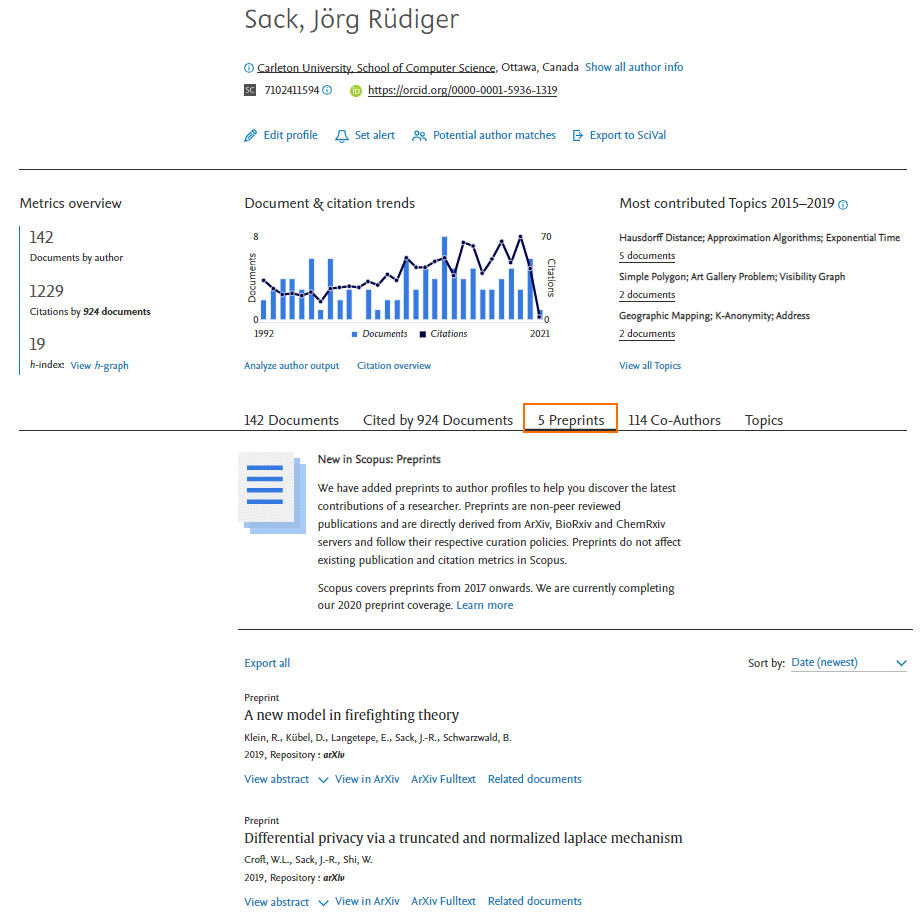We are excited to announce that Scopus is now incorporating preprints as a content type in Author Profiles to help Scopus users discover the latest contributions of a researcher. Preprints are non-peer-reviewed publications and are directly derived from arXiv, bioRxiv, ChemRxiv and medRxiv servers (with SSRN coming later this year) and follow their respective curation policies. Preprints do not affect existing publication and citation metrics in Scopus.
Scopus covers preprints from 2017 onwards.

What are preprints?
A preprint is a version of a scholarly paper that precedes publication in a peer-reviewed journal and act as an early indication of research.
Preprints reside on preprint servers, which cover a set of domains and allow for dissemination, laying claim to an idea, and help collect feedback prior to submission. In some fields, preprints are the main communication vehicle. Preprints differ from Articles-in-Press in that preprints are not peer-reviewed and not accepted for publication in a journal.
Frequently Asked Questions
Why introduce preprints into Scopus author profiles?
As Scopus data is increasingly used as an evaluation and decision support tool, we see the need to look at scholarly output through the researcher lens in. Preprints provide a more detailed view of researchers and what scholarly work they create over the course of their careers.
Preprints support several clear use cases:
- To assess if other researchers are performing cutting edge, innovative research allowing other researchers to identify potential collaboration partners.
- To read or assess another researcher’s most recent work.
- To get a more comprehensive portfolio overview.
- To allow funding agencies to assess funding applications, monitor project progress, and demonstrate impact through early forms of scholarly output.
How are preprints incorporated into author profiles?
Preprints are only available for authors that already have a peer-reviewed publication history in Scopus and they are clearly separated from the curated published content. Neither citations to-and-from the preprints, nor links with the final version of the article are captured. Metrics on Scopus, such as publication and citation counts, h-index, and others exclude preprint content.
What preprints are included?
The preprint servers selected for Scopus are the main preprint servers in the areas of Physical Sciences (arXiv and ChemRxiv) and Biomedical Sciences (bioRxiv and medRxiv). These are >600k preprints in total which has enriched 1M author profiles. Social Sciences (SSRN) will be added to Scopus during the first half of 2021.
Why preprints and not meeting abstracts?
Preprints are deemed as a more valuable signal of research focus than meeting abstracts. Meeting abstracts are not a complete and unique record of research and can drive ambiguity or duplication. Furthermore, unlike preprints which represent a complete piece of work, the scientific content and substance of meeting abstracts is limited as they are typically written before the actual research is complete.
How does Scopus compare to other products in its implementation of preprints?
The implementation of preprints in Scopus is superior compared to other products in the industry, allowing users to use preprint data with the same confidence they do journals data. Scopus has created best in class records of the preprint and provide high quality linking to researchers. Furthermore, our data is deduplicated (we take care of versioning) and we extract maximum data from the original source, subject to license restrictions. We provide the richest metadata about any preprint manuscript available and the most complete and correct researcher profiles based on preprints.
Does adding preprints to Scopus influence university rankings?
Preprints are not integrated into institution profiles or metrics and do not influence assessment.
Which metrics (such as citations) are included for preprints?
Preprints are not integrated into any metrics in Scopus and do not influence assessment, including citation counts. The version-of-record (published, peer-reviewed articles) are the official representation of the research in Scopus.
Is there be a feedback mechanism (similar to the Author Feedback Wizard) for preprints?
Scopus does not yet provide the functionality to receive corrective feedback about an author's preprint record. Contact the content support desk for any feedback regarding preprint content in author profiles. Scopus content support only considers feedback about profiling for the preprints indexed in Scopus (see Which prints are included? for information).
What happens if a preprint is later published? Does it go away, i.e. does the published version take the place of the preprint?
If the research work exists as both a preprint and as a publication, the preprint lives in parallel with the published article. Preprints and the published article are different entities where the contents are not identical. Preprints are not integrated into any metrics or statistics in Scopus, therefore only the published articles are counted and represent the body of research in the metrics and statistics. The possibility of linking preprints to the corresponding published version is being evaluated.
Preprints versioning is pro-actively managed to include only the latest version of a preprint in Scopus.
When are you going to add preprints to Scopus API? Customers are likely to want to use these data to populate CRIS/RIM Systems/repositories.
Scopus will evaluate the needs for API based on customer feedback, then decide what features to add or modify for preprints.
